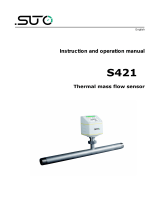Calib_{MULT})\label{2}\tag{2}$$
The reference value for the short is considered to be 0: $R_{0} = 0$
The calibration coefficients are applied to the acquired value in the following manner: $$Value_{corrected}=(1 +
Calib_{MULT})Value_{acquired} + Calib_{ADD}\label{3}\tag{3}$$
This method applies to the DC Voltage and DC Current scales. It collects the pairs (RefVal, MsVal) in three points: 0 point (short between
probes for voltage and open for current), negative full scale value and positive full scale value. For example, for VoltageDC500m scale, the
following points are used: 0 point (short between probes), -500mV, 500 mV.
Let’s consider this pairs as being ($R_{0}$, $M_{0}$), ($R_{FN}$, $M_{FN}$) and ($R_{FP}$, $M_{FP}$). The calibration coefficients are
computed in the following manner:
$$Calib_{MULT}=\frac {R_{FP} - R_{FN}}{M_{FP} - M_{FN}} - 1\label{4}\tag{4}$$ $$Calib_{ADD}=(R_{0} - M_{0})(1 +
Calib_{MULT})\label{5}\tag{5}$$
The reference value for the zero calibration is considered to be 0: $R_{0} = 0$
The calibration coefficients are applied to the acquired value in the following manner: $$Value_{corrected}=(1 +
Calib_{MULT})Value_{acquired} + Calib_{ADD}\label{6}\tag{6}$$
This method applies to the AC Voltage and AC Current scales. It collects the pairs (RefVal, MsVal) in two points: 0 point (short between
probes for voltage and open for current) and full scale value. For example, for VoltageAC500m scale, the following points are used: 0 point
(short between probes) and 500 mV.
Let’s consider this pairs as being ($R_{0}$, $M_{0}$), ($R_{F}$, $M_{F}$). The calibration coefficients are computed in the following manner:
$$Calib_{MULT}=\frac {R_{F}}{\sqrt{{M_{F}}^2 - {M_{0}}^2}} - 1\label{7}\tag{7}$$ $$Calib_{ADD}= M_{0}\label{8}\tag{8}$$
The reference value for the zero calibration is considered to be 0: $R_{0} = 0$
The calibration coefficients are applied to the acquired value in the following manner: $$Value_{corrected}=(1 + Calib_{MULT})\sqrt{|
{Value_{acquired}}^2- {Calib_{ADD}}^2 |}\label{9}\tag{9}$$
Digilent provides libraries to access DMM Shield functionality. The libraries were created to support ZYNQ plaform and Digilent PIC32
microcontroller boards. Both libraries come with a demo that allows the communication with the DMM Shield through UART. Functions as
setting a scale and measure can be accessed by entering commands in the UART terminal emulator. Another demo shows how to access the
memory left in the EEPROM by reading and writing 32 words. Documentation and downloads for these libraries can be found at the following
locations:
ZYNQ
PIC32
Arduino








